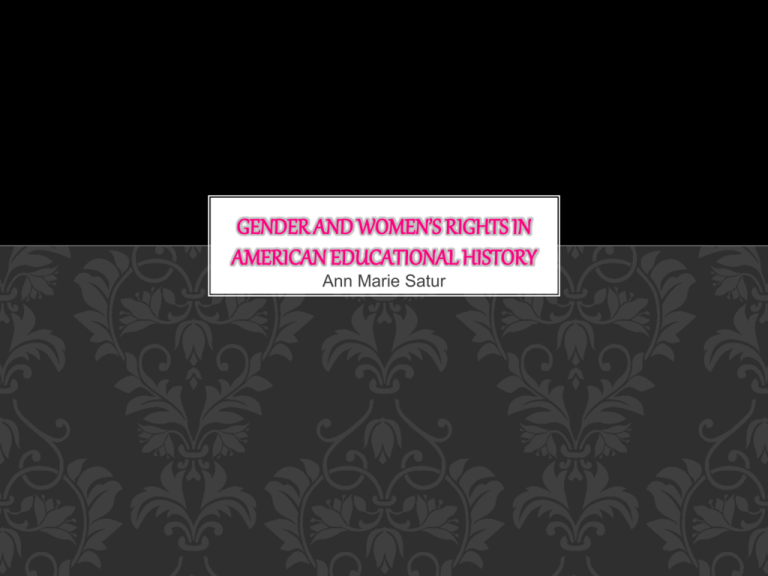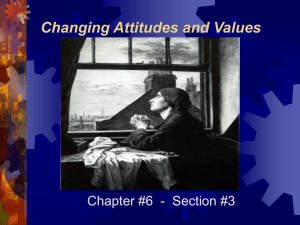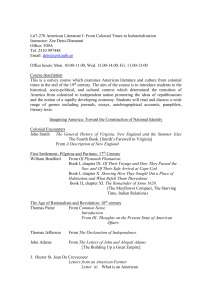File - ED 282 MultiCultural education Ashley b. Castro
advertisement

GENDER AND WOMEN’S RIGHTS IN AMERICAN EDUCATIONAL HISTORY Ann Marie Satur NORMS • • • • Cell phones on silent Respect others Engage in discussion Have fun! SLO’S Students will be able to 1. Describe what rights, if any, women had in the colonial, postcolonial, and modern-day US. 2. Discuss the history and development of the suffragist movement 3. Identify and describe such prominent pioneer feminists as Ann Hutchinson, Sarah Grimke, Sojourner Truth, and other leading figures of the suffrage movement. BELLWORK • What do you think the world would be like today if women had no rights? GENDER AND WOMEN’S RIGHTS IN COLONIAL AMERICA • • • • Blackstone Commentaries Colonial girls grew up mothers and wives Colonial women did not accept second-class position Anne Hutchinson • • • • Banished from Boston for teaching God’s ways to colonial males Children were viewed as economic help Illiterate colonial women Community-based schools typically excluded girls • Read the scriptures • Land Ownership ANNE HUTCHINSON • Learned theology from her father • In the New World, served God publicly but quietly • Divine grace required human cooperation vs. covenant of grace totally depended on God • Depended on God • Governor of Massachusetts attended her meetings • Spoke freely about ministers • Turned almost all of Boston against their ministers • Earliest feminist in the new world GENDER AND WOMEN’S RIGHTS DURING AND AFTER THE AMERICAN REVOLUTION • Restricted women’s rights and opportunities • Women dared to challenge the system, men who supported them • 1745, Susanna Wright – first woman to provide notary services in the colony • Legal counsel, prepared wills, deeds, other legal contracts • 1764 James Otis – questions whether women were born as free as men • 1175- Thomas Paine published Pennsylvania Magazine • Proposed women’s rights ABIGAIL ADAMS • No formal schooling • Took advantage of her father’s library and tutorial skills of family neighbors and friends • Abby and her sister, most educated women of their time • John Adams (Husband) • Intellectual equal • • • • Discussed politics 1776 – Continental Congress: “all men are created equal” 1777 – women were denied their right to vote 1789 – Constitution was ratified. New terms added “people, persons, and electors” GENDER AND WOMEN’S RIGHTS DURING THE ABOLITION MOVEMENT • • • • • • • • • • 1790 – New Jersey extended voting rights to women 1807 – male politician (men, I tell you!) 1821 – Emma Hart Willard ->Troy Female Seminary established in NY First endowed school for girls in the nation (yay!) Sarah Margaret Fuller -> writings and ideas challenged men’s claim to superiority -> possessed one of the most powerful and creative minds in her generation ->wrote Women in the Nineteenth Century Sarah Grimke began a speaking career on slave abolition and women’s rights -> First female Anti-Slave Society Convention held in NY 1839 – Mississippi -> Women’s Property CONTINUED • • • • • • • • 1844 – Lowell Female Labor Reform Association (LFLRA) ->demanded a ten-hour work week -> first permanent labor association for women in US history 1848 – Declaration of Sentiments 1855 – Missouri vs. Celia Quakers extended educational rights to women Abby Kelley Foster – spoke at the Fourth National Woman’s Rights Conventions Civil War breakout lead to a setback in activities SOJOURNER THE TRUTH GENDER AND WOMEN’S RIGHTS AFTER THE CIVIL WAR • Elizabeth Cady Stanton & Susan B. Anthony formed the American Equal Rights Association (heavily influenced by Margaret Fuller) • Lucy Stone, Henry Blackwell, and Julia Ward Howe -> American Woman Suffrage Association (AWSA) • 1868- 14th amendment was ratified, extending constitutional rights and protection to all citizens • 1869- first woman’s suffrage law passed in Wyoming • 1870- 15th amendment final ratification stating, “The right of citizens of the United States to Vote shall not be denied or abridged by the United States or by any other State on account of race, color, or previous condition of servitude.” (uh, where’s the women?) • ->Wyoming had its first sexually integrated Grand Jury CONTINUED • 1872 – Susan B. Anthony arrested for attempting to vote in the Presidential Election • ->Sojourner Truth demanded a ballot during the same Election • 1873 – US Supreme court ruled a state had the right to exclude a married woman from practicing law. • 1875- Minor v. Happersett Supreme Court ruled a state could prohibit a woman from voting • 1895- Elizabeth Cady Stanton (NAWSA) published Woman’s Bible. Not such a great idea. Resigned as President. Never invited to sit on stage at conventions • 1896 – Nat’l Association of Colored Women was founded by Harriet Tubam, Fanny Jackson Coppin, Francis Ellen Watkins Harper, Mary Church Terrell, Margaret Margaret Murray Washington, Ida B. Wells Barnett, & Charlotte Forteen Grimke • Let’s take a look at page 155 GENDER AND WOMEN’S RIGHT IN THE 20TH AND 21ST CENTURY • • • • Most progressive era in Women’s Rights Educational enhances 1903 – organization of middle class and working class women -> Mary Drier, Rheta Child Dorr, and Leonora O’Reilly (Women’s Trade Union League of New York – International Ladies Garment Workers Union) “Women were created from the rib of man to be beside him, not from his head to top him, nor from his feet to be trampled by him, but from under his arm to be protected by him, near to his heart to be loved by him.”









